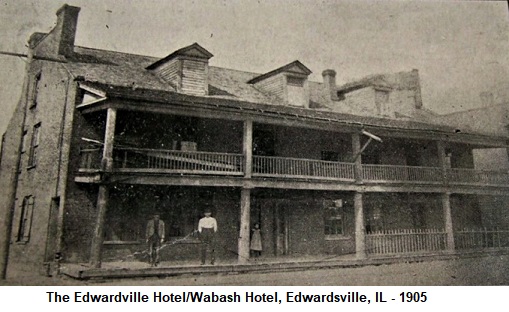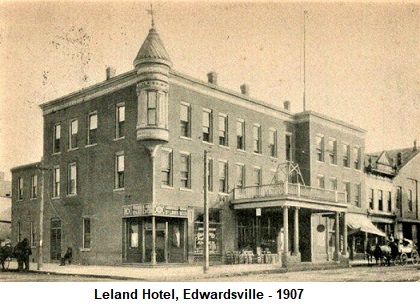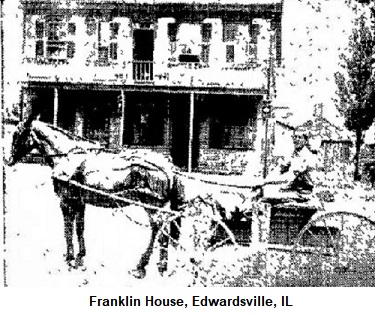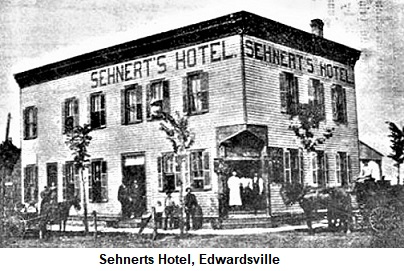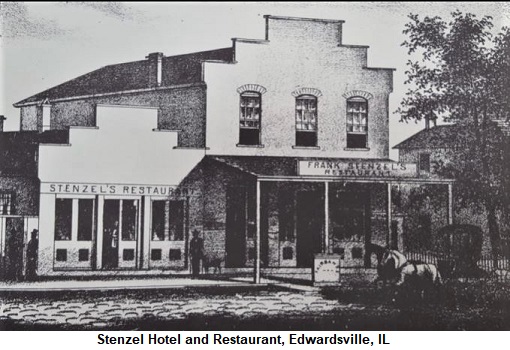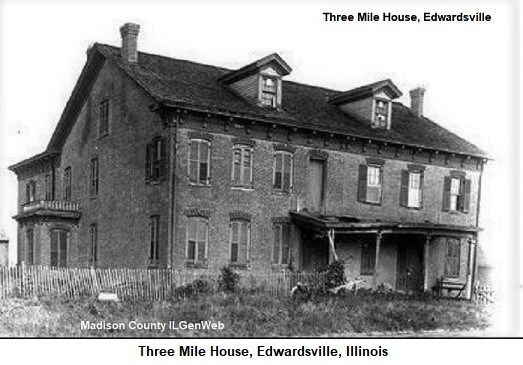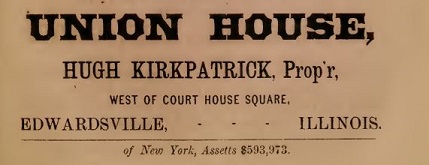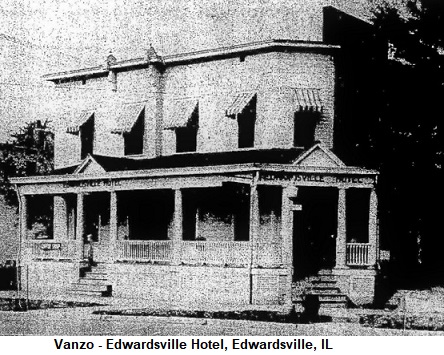Edwardsville Hotels
Edwardsville History | Newspaper Articles
BERNREUTHER
HOUSE
The Bernreuther House was a boarding house on Main Street, kept by
Daniel Bernreuther. It was opened in about 1867. He continued the
business until 1893. Bernreuther was born in Germany on December 11,
1823. He came to America in 1843, living first in St. Louis, where
he learned the cooper’s trade. He married on July 21, 1853, to
Wilhelmina Grotte, and the couple moved to Edwardsville on March 20,
1855. Until 1867, he was engaged in the cooper business, and then
opened the boarding house. He died in July 1895, at the age of 71,
and is buried in the Woodlawn Cemetery in Edwardsville.
BROADWAY HOUSE
The Broadway House was a two-story building located at the corner of
Main and Vandalia Streets. Mr. Kelly was the proprietor in October
1865. In
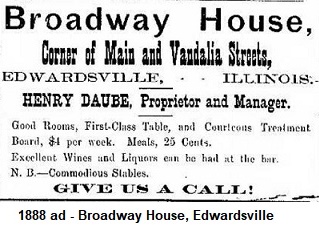
In January 1909, the Broadway House opened under new management.
Mrs. Evada Floyd was the manager and proprietor, and she refurnished
the hotel. Joseph Stremcha was in charge of the saloon. In 1912, S.
H. Lanham took over the hotel.
Ike Schwartz, founder of Schwartz Furniture Store, purchased the
Broadway House and adjoining property in about 1919, and tore down a
large portion of the buildings and erected a new hotel in 1922 - the
Diamond Hotel.
DIAMOND HOTEL/STAR
HOTEL
In 1922, Ike Schwartz, founder of Schwartz Furniture Co. in
Edwardsville, erected a hotel at the northwest corner of Main and
Vandalia Streets. The
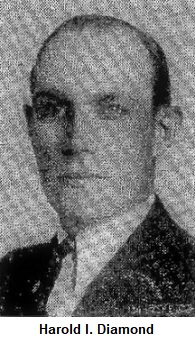
In December 1926, the hotel business was purchased by Christ
Pantazis, and arrangements were made for a new entrance at the
corner of Main and Vandalia Streets. The name was changed to the
Star Hotel. Pantazis formerly operated the Unique Restaurant in
Edwardsville.
The Star Hotel was destroyed by fire in August 1934. It was believed
to have started in the Star Restaurant, where George Crist, the
business owner at that time,
had started to make coffee. He turned on a gas burner, and went to a
nearby store to make purchases. Upon his return, he smelled smoke.
Between 70 and 80 people were sleeping in the second story rooms.
During the fire, wind came from the north and threatened buildings
on the south side of Vandalia Street. Nearby, Schwartz Furniture
Company, the Edwardsville Cloak & Suit Company, and the Palace Store
sustained heavy damage. Ten people were injured.
In 1938, a new building (named the Schwartz Building) was erected on
the site of the former hotel by the widow and heirs of Ike Schwartz.
The modern design, brick structure housed the Schwartz Furniture Co.
J. C. Penney, Ballweg Pharmacy and Ben Franklin on the first floor,
the B. and R. Bowling Alley in the basement, and eleven modern
apartments on the second floor.
Ike Schwartz, at the age of 16, came to America as a poor immigrant
from Poland. In 1900, he settled in Collinsville, and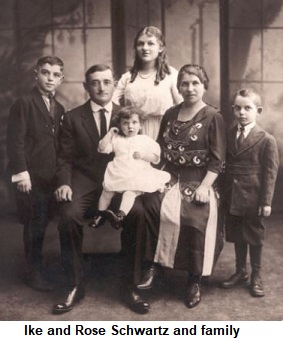
EDWARDSVILLE HOTEL/WABASH HOTEL
The Edwardsville Hotel, located at North Main and Union Streets, was
opened in about 1842. Previously another hotel stood on the
property, built by John T. Lusk. That hotel was destroyed by fire in
1839. The Edwardsville Hotel was a temperance hotel,
meaning no liquors. The brick building housed a dining room, coffee
shop, and spacious porch which invited guests to sit outside and
watch the trolleys go by. Among the honored guests at the
Edwardsville Hotel were Abraham Lincoln and Stephen A. Douglas. In
1852, the hotel was sold to Mr. Thomas W. Yates for $4,000. In 1872,
the name of the hotel was changed to the Wabash Hotel by Mrs. Small,
a widow who then operated the hotel. In March of that year, a fire
damaged the cellar and first floor, but the building was repaired.
Later, the hotel was kept by Mrs. Anna Swarz. In 1883, Fritz and
Henry Roethig owned the hotel, and later it was operated by the
Pfeiffer family for many years. In 1937, Edward Smith was
proprietor. The building still stands, and is used for apartments.
NEW TEMPERANCE HOTEL IN EDWARDSVILLE
(Edwardsville Hotel)
Source: Alton Telegraph, February 19, 1842
It will be observed by a notice in another column that a "Temperance
house," for the accommodation of travelers and the public in
general, has been recently opened in the neighboring town of
Edwardsville, the seat of justice for this county, by Mr. C.
Roberts. Not having visited Edwardsville since the opening of this
house, we are unable to speak of its accommodations from personal
observation, but we learn from authentic sources that it well
deserves the patronage of the friends of Temperance and good order.
EDWARDSVILLE HOTEL DAMAGED BY FIRE
Source: Alton Telegraph, March 1, 1872
The Edwardsville Hotel on Main Street caught fire about three
o’clock this morning, and it was only by the most strenuous
exertions on the part of the citizens that the building was saved
from destruction. The fire originated between the cellar and the
first floor, and from all accounts, appears to have been the work of
an incendiary. Had the fire once gained the mastery, it would have
swept the greater part of the block. The loss is small and is
covered by insurance.
NAMED CHANGED TO WABASH HOTEL
Source: Alton Telegraph, April 26, 1872
The old brick hotel, formerly known as the Edwardsville Hotel, has
been rejuvenated and is being kept by a widow lady, who has changed
its name to Wabash Hotel. The project for building a magnificent
hotel here seems to wane. Mr. Kirkpatrick, however, its proposed
proprietor, is still running the Union Hotel, and is meeting with
success.
PROPRIETOR OF WABASH WHIPS MAN
Source: Alton Telegraph, October 11, 1872
A slight unpleasantness, resulting in Mrs. Small, proprietress of
the Wabash Hotel, cowhiding a man by the name of Nevill, took place
in the office of our Police Magistrate last Monday. Nevill, it
seems, was a witness in a suit, wherein said hotel proprietress was
concerned, and his testimony did not suit her, and the whipping she
gave him was equally unsatisfactory to him. Hence, she had to make
redress in the shape of a fine of fifteen dollars and costs. We are
not advised as to whether the boys who seemed to enjoy the fray so
well assisted in paying the fine or not.
WILD NIGHT AT WABASH HOTEL
Patrick McCambridge Sr. Shot and Killed
Source: Alton Telegraph, September 27, 1883
From Edwardsville, September 25 – Old man McCambridge, a coal miner
about 70 years of age, was shot and killed about eleven o’clock last
night on the sidewalk near the Wabash Hotel in lower town in
Edwardsville. The house is kept by Fritz and Henry Roethig, and as
has been their custom, they had advertised that a ball would be
given there last night. Quite a considerable number of men and boys,
but few, if any, ladies put in an appearance. During the evening,
some dispute arose between some of the patrons of the bar and the
barkeeper, as to who should pay for the drinks, resulting in the
proprietors closing the doors. The disaffected patrons, after
receiving a few persuaders with a club, and giving the house a
parting salute with brickbats, retreated up town. Among them were
Patrick and Henry McCambridge, sons of Patrick McCambridge Sr. (the
deceased), John Buncher, Barney Perkins, Patrick McMahon, William
Schramek, and George Sipe.
The McCambridge boys, and one or two more of their party, after
arriving at home, concluded to return to the hotel, and soon after
were followed by the old man McCambridge, who got out of bed,
accompanied by George Shaffer, also a coal miner, to try to prevent
the boys from having any further trouble. Soon after arriving at the
hotel, it seems the old man succeeded in getting the boys started
towards home, but before they had got out of pistol range of the
hotel, several shots were fired, one or two from the porch of the
hotel, one or two from some person in the cross street nearby, and
two or three from some on the sidewalk. One shot took effect in the
body of old man McCambridge, who expired in a few minutes. The
proprietors of the hotel are both in jail, charged with the bloody
deed, having waived examination until after the Coroner’s inquest,
which is being held by Coroner Youree this afternoon.
NOTES:
Patrick McMahan, George Seip, Barney Perkins, Patrick McCambridge
Jr., Daniel McCambridge, and John Buncher were indicted with assault
with intent to kill, for the riot and melee at the Wabash Hotel,
where one of the proprietors (Roethig) was wounded, and Patrick
McCambridge Sr. was killed. They were fined $50 each, and granted
suspension of execution for good behavior, except in the case of
George Seip, whose father was one of Edwardsville’s wealthy
citizens, and who paid the fine and costs. The owners of the hotel
were not held responsible for the death of McCambridge Sr.
Patrick McCambridge Jr. became Deputy Sheriff in Edwardsville in
1891, and was then elected Chief of Police in Madison, Illinois.
Patrick Jr. died on February 25, 1933.
EMPIRE HOUSE/BENTON HOUSE/HOFFMAN HOUSE/LELAND HOTEL
The Empire House in Edwardsville was located on the southwest corner
of St. Louis and N. Main Streets, on the south side of the
courthouse square.
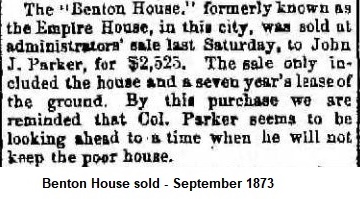
In October 1892, Athanas Hoffmann purchased the former Benton House, and changed
the name to the Hoffman House. In 1893, Hoffmann erected practically
a new structure on the site of the old building. It was a brick
building, three stories high, with a distinctive corner turret. He remodeled the interior with new carpets, matting, and furniture. The
hotel included a large office and lobby; reading room; barbershop;
bath and toilet rooms; cigar stand; barroom; and an office for the
Postal Cable and Telegraph, with a type writer in attendance. The
hotel was heated by steam, with every room and hallway being
provided with radiators. An electric call bell system was introduced
for communication between the guests and office.
The hotel was purchased for $22,060 in June 1896 by C. B. Gonterman,
C. N. Travous, and W. M. Warnock, who formed the Edwardsville Hotel
Company. In 1896 it was leased to W. L. Leland of Cincinnati, and
renamed the Leland Hotel. Mr. Leland remodeled the hotel with new
wallpaper and paint throughout, a new system of plumbing, including
hot and cold water, electric call bells, electric lights, bathrooms,
steam heat, new carpet, lace curtains, and new furniture. The dining
hall was decorated in blue and gold, with polished brass electric
chandeliers. The hotel opened once again to the public in January
1897.
In 1905, G. D. Burroughs and W. M. Warnock took over the company.
The establishment was leased to different parties throughout the
years. Most of the hotel was razed in 1923 to make way for the
Edwardsville National Bank building. The Leland Barber Shop, located
on the first floor, opened in the 1880s. This part of the hotel last
for 50 more years after most of the hotel was razed. The barbershop
was then razed in November 1973, and a small park put there.
BENTON HOUSE
Source: Edwardsville Intelligencer, October 16, 1873
The proprietor of the Benton House informs us that he expects to
have all manner of game on his tables for the next month or more,
and his customers will be otherwise fed upon the fat of the land.
His oyster saloon is in full blast, supplied with the choicest and
richest bi-valves, received fresh by express every day.
BENTON HOUSE CLOSED
Source: Alton Telegraph, July 9, 1874
The Benton House has been closed under a chattel mortgage. The
furniture is to be sold on July 18. Charlie, although nursing a hand
with a bullet hole through it, seems to be as wide awake as ever,
and determined to enjoy life as long as he sees other people living.
The closing of the Benton House virtually gives the Union House a
monopoly of the hotel business in Edwardsville. But this state of
affairs is not expected to continue very long. Mr. Kirkpatrick,
however, is not the man that would take advantage of his patrons,
even though he should continue to be the proprietor of the only
hotel in the city. He takes pleasure in looking after the interest
and comfort of his guests, and gives them value received for their
money.
HOFFMAN HOUSE
Source: Edwardsville Intelligencer, February 01, 1893
Not many cities the size of Edwardsville have as handsome hotels.
During the past months, a practically new structure has been erected
on the site and lots adjoining the old Hoffman House. The new
hostelry has a frontage on the court square of 90 feet, and a depth
on Main Street of 80 feet. It is three stories high and of brick. It
has a large office and lobby, reading room, barbershop, bath and
toilet rooms. The Postal Cable and Telegraph Co. have an office in
the building, and a type writer is in attendance. A barroom and
cigar stand add to the convenience of the wayfarer. The dining room
will comfortably seat 150 persons, is well lighted, and cheerful.
There are fifty rooms on the second and third floors, a reception
room and large double parlors. The carpeting, furnishing, and
appointments are equal to that found in the first-class hotels of
the large cities. Good taste has been displayed, and neither money
nor pains have been spared to make the hotel comfortable and
convenient. The building is heated by steam, every room and hall
being provided with radiators. Ninety-five electric lights are
necessary to light it. An electric call bell system has been
introduced, by means of which communication may be had from any room
with the office. The hotel is owned and managed by Athanas Hoffmann,
an old and favorably known hotel man, his wife having immediate
supervision of the house. Mr. Hoffmann has reason to feel proud of
his new hotel, where he can accommodate his many friends among the
traveling public. His terms are reasonable, appointments considered,
and he has reason to expect a liberal patronage.
LELAND HOTEL
Source: Edwardsville Intelligencer, January 1, 1897
Few scenes of greater activity could be imagined than has been
presented by the Leland Hotel during the past few days. The work of
repair and refurnishing, which has been going on for the past month,
is drawing toward completion, and the appearance of the building,
both inside and out, bespeaks eloquently of the care and time
lavished upon it. The work done has been thorough and entire, no
portion of the building being neglected. New paper and paint
throughout, a complete new system of plumbing, including hot and
cold-water service, electric call bells, electric lights, bathrooms,
steam heat and other appurtenances that contribute to the wayfarer’s
comfort, render it one of the best-appointed hotels in this part of
the State.
The building has been furnished by the owners without scruple as to
cost, being provided with brussels carpets, lace curtains, new and
tasty furniture, etc. The decorations are varied and effective. In
the office and lobby, terra cotta is the prevailing color, relieved
by mouldings of light blue. The room is surrounded with an artistic
wainscot of lincrusts, stamped in neat design. The stairways have
similar wainscot. The dining hall is decorated in blue and gold, and
has polished brass electric chandeliers. In the second and third
stories, the finishings are of quiet hue, all attractive, but in
perfect good taste.
The building is owned by the Edwardsville Hotel Co., composed of
Messrs. C. N. Travous, W. M. Warnock, and C. B. Gonterman, who have
leased it entire to W. H. Leland of Cincinnati, Ohio. The new
management gives promise of being eminently successful. Thomas
O’Connor has been engaged as clerk. Eugene M. Ronk of St. Louis, who
has been chef in some of the best-known establishments in that city,
will serve in like capacity here. Miss M. E. ___ will have
supervision of the storeroom and culinary department, and Miss Flora
____ will be housekeeper. Mr. Leland, the manager, is a gentleman of
wide experience in the hotel business, having been engaged in it for
over 25 years. He was at different times connected with the Grand
Hotel and Gibson House in Cincinnati, the Antlers Hotel, Colorado
Springs, and several well-known hostelries in Virginia. He is firmly
convinced that the new venture will be a success, and will maintain
the house at a high standard of excellence. The building will be
thrown open to the public on next Thursday evening, January 7, at
the opening ball, and its new career will begin with the serving of
breakfast on Friday morning.
ACTRESS INJURED IN LELAND HOTEL FIRE
Source: The New York Times, New York, March 7, 1905
St. Louis, Missouri, March 6. -- Miss Victory Bateman, an actress,
narrowly escaped burning to death in a fire at the Leland Hotel in
Edwardsville, Ill., today. It is said to-night she is in a
precarious condition. Miss Bateman was visiting friends in the "Dr.
Jekyll and Mr. Hyde" company which is under the management of Oscar
Dane and played in Edwardsville tonight. Miss Bateman was with Mr.
Dane in a stock company of which the latter was manager and intended
to watch the rehearsal at the Tuxhorn Opera House this afternoon.
She had gone to her room to take a nap after dinner and about 3
o'clock a member of the company, who had gone to the third floor to
summon her saw smoke coming from beneath the door. The proprietor
broke in the door. A cloud of smoke and flame surged into the hall.
The proprietor crawled in on hands and knees and encountered the
form of the unconscious woman lying on the floor. She was dragged
out and medical attention was given her.
NOTES
Victory Bateman (April 6, 1865 - March 2, 1926) was an American
silent film actress. Her father, Thomas Creese, and her mother,
Elizabeth "Lizzie" Creese, were both actors. She was born nine days
before Abraham Lincoln was assassinated, and was named Victory
because of the North's win over the Confederate South, ending the
Civil War.
FRANKLIN HOUSE
The Franklin House was the social center of the “Old Town,” or
northwest section of North Main Street. The hotel stood on the
southeast corner of Main and Union. The building was torn down years
ago. A gas station later stood on the property.
GENERAL WASHINGTON HOTEL
The General Washington Hotel was opened in 1819 by William C.
Wiggins. The brick hotel stood on the northeast corner of the public
square in “Old Town,” east of the old jail. The General Washington
had an extensive and fashionable patronage, and many distinguished
men ate and slept within its walls, including prominent doctors,
lawyers, and Governor Edward Coles (inaugurated in 1822), who
boarded at the hotel for many years. Its walls were so badly cracked
by an earthquake, that it was necessary to abandon the building. It
was purchased by Isaac Prickett, who torn the building down and used
the brick to build two small houses on Main Street.
William C. Wiggins was born in New York on November 16, 1783. He
settled in Edwardsville, and opened the hotel in 1819. Wiggins also
purchased the rights to operate a ferry between St. Louis and
Illinois from Captain James S. Piggott. From its small beginnings
and makeshift rafts, the Wiggins Ferry Company built a large
business, transporting people to and from St. Louis. By the 1820s,
Wiggins had a fleet of ferryboats with names such as “Sea Serpent,”
“Rhinoceros,” and “Antelope.” He even experimented with ferries
powered by horses on treadmills. In 1830, Wiggins upgraded to steam
power, with the “St. Clair” and “Ibez” ferries making two regular
daily river crossings. Wiggins died on November 28, 1853, and was
buried in the Bellefontaine Cemetery in St. Louis. Surviving was his
wife, Mary Berrien Wiggins, and three sons, Samuel, Edward, and
Charles.
By the early 1870s, the former Wiggins company (possibly ran by his
descendants) was averaging 1,500 people, 10,000 bushels of coal, and
750 wagons daily on his ferries. In 1893, the company was sold to
the Terminal Railroad Association. They kept the still-profitable
ferry going for a short time. When the Municipal (MacArthur) Bridge
opened in 1917 as a toll-free passage across the river, the ferry
company was doomed. The last of the ferryboats stopped running in
the early 1930s.
HOPKINS HOTEL
William H. Hopkins had a hotel in “upper town.” It was a frame
building, which stood opposite the southeast corner of the public
square, near the residence of Henry C. Gerke.
LUSK HOTEL
John Thomas Lusk was the proprietor of the first hotel in
Edwardsville. It was located on Main Street, opposite the former
Lincoln School, and was opened in about 1815. Lusk was born in 1784
in South Carolina, came to Madison County in 1805, and settled in
Edwardsville. In 1809, he married Lucretia, daughter of Charles
Gillham. He was a Ranger during the War of 1812-14. While the men
were absent, the women sought refuge in the fort, and Mr. Lusk’s
wife was appointed their Captain. She was an excellent rifle shot
and had plenty of spirit and bravery. Lusk erected a story and a
half tall building of heavy logs, with three rooms on the ground
floor, where he opened the first hotel in Edwardsville. He served as
Deputy Circuit Clerk under Hail Mason, and afterward filled of the
office of County Clerk, Recorder, and Postmaster. After Lusk closed
the hotel, the center of these rooms was used for the post office.
One end was rented to Mrs. Howard, who kept a pie and cake shop. The
other end was a saloon. Lusk died on December 22, 1857.
Second Lusk Hotel
A second hotel was constructed by John T. Lusk on the property later
occupied by the Wabash Hotel. It was a large frame building, which
was destroyed by fire in 1839. Meriam Patterson kept this hotel for
a time. His successor was Horatio G. Street, and he was followed by
Cassius Hesket. While Mr. Street was proprietor, in about 1830, it
was renowned for the excellence of its fare and the superior manner
in which it was conducted. The fashionable people of St. Louis
patronized it during the summer months, and on Sundays it was a
frequent resort of Alton citizens. During Hesket’s administration,
the old frame building burned down. Another structure was erected in
its place, and was considered a remarkably fine specimen of
architecture.
SEHNERT HOTEL/LIEBLER HOTEL
The Sehnert Hotel was located at the corner of South Fillmore and
Wolf Streets, near the Cloverleaf Depot. It was once operated on a
large scale for a number of factory and railroad employees who
resided there. A tavern, first called the Clover Leaf Saloon, was
also located in the hotel. The hotel opened in about 1894. In 1910,
the name changed to the Liebler Hotel, when Joseph Liebler took
possession. In 1945, it became the Corner Place Tavern when Dora
Cathcart took over the former hotel. Later the name was changed to
the Corner Tavern, with apartments on the second floor.
STENZEL HOTEL AND
BAKERY
The Stenzel Hotel and Bakery was owned by Frank Stenzel, and was
located opposite the south door of the courthouse, at 114 St. Louis
Street. The hotel portion was erected in 1881. The hotel dining room
was considered as having one of the best meals available in
Edwardsville. At one time, Mr. Stenzel conducted a saloon in one of
the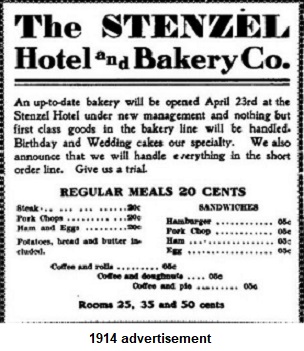
After Stenzel's death in July 1926, the hotel and his home on South
Main Street was sold. In December 1920, the hotel was owned by C. L.
Maher. In 1931, the hotel was used to house 50 to 75 construction
workers, who were building the Nickel Plate Railroad (Clover Leaf).
Parts of the building were then wrecked, and the old hotel was
remodeled for the location of the Illinois Power and Light
Corporation and office of the Illinois Terminal Railroad.
STENZEL HOTEL
Source: Alton Telegraph, April 7, 1881
Frank Stenzel, our enterprising fellow citizen, proprietor of the
two-story brick saloon and restaurant opposite the south corner of
the court house square, has bought the property adjoining on the
east, known as the court house exchange, and also the frame house
and lot adjoining him on the west, and we understand he is going to
remove a portion of the buildings thereon, and build a hotel.
ST. JAMES HOTEL
Hugh Kirkpatrick was born in Randolph County, Illinois, in September
1832. He engaged as a clerk in St. Louis for two years, then lived
in Sparta, working as a salesman. He later embarked in the
mercantile business, then opened the Shannon House in Sparta. He
moved to Edwardsville in 1861, and in October of that year opened
the Union House, which he conducted with considerable success until
1874. For several years he had entertained the idea of building a
large hotel in Edwardsville. He began work on the brick
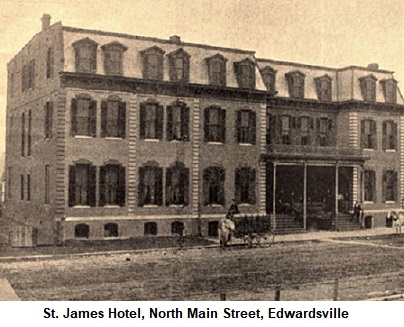 structure,
and in 1874 the St. James Hotel was opened. The St. James was one of
the finest hotels in the area. Kirkpatrick died in May 1895, leaving
a widow and four children. His funeral was held at the St. James.
structure,
and in 1874 the St. James Hotel was opened. The St. James was one of
the finest hotels in the area. Kirkpatrick died in May 1895, leaving
a widow and four children. His funeral was held at the St. James.
The St. James Hotel was located on the east side of North Main
Street, just south of the Wildey Theater. Including grounds and
furniture, it cost $20,000. It was a fine brick structure, three
stories high, with a basement. It had the capacity of accommodating
75 guests, and had two sample-rooms, a commodious office, and a
dining room. An 800-seat opera house – the Tuxhorn Theater - was
connected to the St. James by a second-floor walkway.
The St. James was destroyed by fire in October 1932. The remains of
the building were razed in April 1934. A parking lot now stands at
the site.
ST. JAMES HOTEL
Dated November 12, 1873
Source: Alton Telegraph, November 14, 1873
Our citizens are pleased with the prospect which we have for a
splendid hotel. Mr. Kirkpatrick has a large number of hands and
teams employed digging out the earth and removing it for the
basement story and cellar of his new hotel. The brick for that part
of the building is already on the ground, and with favorable
weather, will soon be placed into the walls. The excavation will be
completed this week.
ST. JAMES HOTEL
Source: Alton Telegraph, December 5, 1873
November 26, 1873 - The bricklayers are busy at work on our new
hotel, and in a few days more, the basement walls will be completed.
If anyone doubts that the building is going to be large and
substantial, let him take a look at the massive walls constituting
the foundation.
ST. JAMES HOTEL PROGRESSING
Source: Alton Telegraph, December 10, 1874
The work on the St. James Hotel is progressing quite favorably
towards completion.
GRAND BALL AT ST. JAMES HOTEL
Source: Alton Telegraph, April 15, 1875
The grand ball that “was in have been” at the St. James Hotel in
Edwardsville, on Wednesday night, April 7, has been, and was one of
the most pleasant and agreeable entertainments ever given in this
city. The house with its large, commodious, well furnished, and
brilliantly illuminated rooms, the gentlemanly landlord, and his
“better half,” the fine music, the elegant dancing, the sumptuous
supper, the well-behaved gentlemen, the beautiful and exquisitely
dressed ladies, each and all contributed to make it what it really
was – the ball of the season. In a financial point of view, however,
the success was not quite complete, notwithstanding which a single
word of complaint on the part of anyone has not been uttered. The
ball at the Wabash Hotel the same night was also well attended and
pronounced a pleasant affair by those who were there.
ST. JAMES HOTEL IGNITED BY CINDERS FROM
BLAKE MILLING FIRE
Source: Edwardsville Intelligencer, June 8, 1926
A high wind from the West carried burning fragments across the
central part of town. The awning on the Tri-City Grocery caught
fire, and the St. James Hotel was ignited. Three other business
houses along Main Street were fired by burning embers, but the
blazes were quickly put out without any damage.
THREE MILE
HOUSE
Originally called Gaertner’s Three Mile House, this inn and tavern
opened its doors to travelers along the St. Louis – Springfield
stagecoach road (Rt. 159) in 1860, although construction began in
1858. The inn and tavern were constructed by Frederick Gaertner, a
St. Louis barber who used the major part of his savings to purchase
70 acres northwest of Edwardsville from John Deterding to build the
inn. It was constructed with handmade bricks, fired on site. The
ornamental eave struts, shutters, and roof shingles were made by
hand.
Gaertner gained a reputation as a genial and generous host. His
Three Mile House (so named because it was three miles from
Edwardsville) became a prominent place where local well-to-do
residents attended lavish balls and parties. As the business
prospered, Gaertner enlarged the north portion of the building to
include a dining room, kitchen, tavern, grocery store, and post
office. There were 10 to 15 sleeping rooms on the second floor, and
a large floored attic which could be used for additional sleeping
quarters when needed. A blacksmith shop was built next door in 1863.
A tunnel from the basement of the inn let to the gazebo in the
cemetery across the road.
The inn flourished until the 1880s, when the growth of the railroad
began to have an impact on stagecoach travel. Gaertner closed the
inn and returned to his birthplace in Pennsylvania. The inn stood
vacant for nearly 25 years, when Gaertner’s son, Tony, sold it to
Orrie Dunlap, a road contractor. Dunlap had the contract to build
and pave Route 112 (now Rt. 159) in 1927, and used the inn as
headquarters for his construction crew. A succession of owners
followed. In the 1940s the inn was operated as a roadside tavern. In
1976, the inn was purchased by the Elliots for use as a restaurant.
They repaired and renovated the building. In 1982 it was sol to John
Henkhaus, who continued the restaurant operations. It was owned by
Steve and Mitzi Ottwell when the inn caught fire in about 1985. It
was then razed. The Ottwell’s then built a ranch style home on the
property.
Three Mile House, located on the west side of Rt. 159, about a
quarter mile north of the railroad tracks, gained a reputation of
being haunted. Some say there were underground tunnels that led from
the basement, and was used as part of the Underground Railroad. All
that remains now is a mound of dirt, and a rusted pole that once
held the sign for the inn.
UNION HOUSE
Hugh Kirkpatrick was born in Randolph County in September 1832. He
engaged as a clerk in St. Louis for two years, then lived in Sparta,
working as a salesman. He later embarked in the mercantile business,
then opened the Shannon House in Sparta. He moved to Edwardsville in
1861, and in October of that year opened the Union House, which he
conducted with considerable success for a period of fourteen years,
or until 1875. The Union House was advertised as “West of Courthouse
Square.” For several years he entertained the idea of building a
large hotel. He began work on the brick structure, and in 1874 the
St. James Hotel opened. The St. James was one of the finest hotels
in the area. Kirkpatrick died in May 1895, leaving a widow and four
children. His funeral was held at the St. James.
VANZO
HOTEL/EDWARDSVILLE HOTEL
The Vanzo Hotel and Saloon was located at 323 St. Louis Street.
Before coming to America in 1885, Frank and Maria Vanzo operated a
cheese shop in Italy. The family’s first saloon was in Bunson,
Indiana. Their son, Louis Simon Vanzo, operated the Big Four Hotel
in Livingston in 1905. Twenty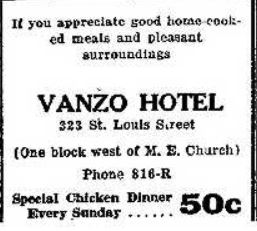
In 1937, Edward Smith, proprietor of a filling station on St. Louis
Road, purchased the former Vanzo Hotel and remodeled and refurnished
the building. The name was changed to the Edwardsville Hotel. The
Edwardsville Hotel was still in business in 1940, but after that I
could not find anything further. The building no longer stands.
FORMER VANZO HOTEL REMODELED
Source: Intelligencer, March 19, 1937
The new Edwardsville Hotel, formerly the Vanzo, at St. Louis and
Benton Streets, recently taken over by Edward Smith, has been opened
for business after the entire structure was redecorated and
refurnished. Regular meals will be served to guests and others. Mr.
Smith said he decided to call it the Edwardsville Hotel after
carefully considering a long list of suggested names. The lobby and
adjoining waiting room were entirely refurnished, as were also each
of the 20 guest rooms. Mrs. Smith is in charge of the kitchen.
